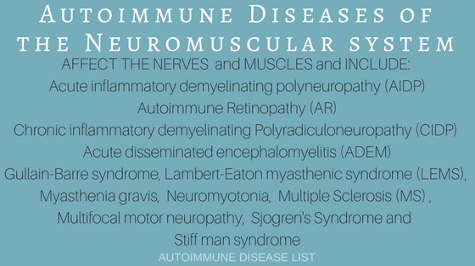
Acute inflammatory demyelinating polyneuropathy (AIDP) mild sensory changes and then weakness in the reflexes that gets progressively worse. EMedicine
Autoimmune Retinopathy (AR) also called recoverin-associated retinopathy(RAR)retinal degeneration causing rapid, painless vision loss associated with sensitivity to light. Casey Eye Institute
Chronic inflammatory demyelinating Polyradiculoneuropathy (CIDP) causes swelling and destruction of myelin sheath over the nerves. Symptoms -weakness, paralysis, and/or impairment of movement in arms and legs. Sometimes numbness, tingling, and burning sensations on both sides of the body. CIDP Home
Encephalomyelitis or Acute disseminated encephalomyelitis (ADEM)inflammation of the brain and spinal cord. NINDS
Gullain-Barre syndrome (Acute inflammatory demyelinating polyneuropathy) affects the body's immune system attacking the nervous system and causing a neuromuscular disease with initial symptoms of weakness and tingling starting in legs and rapid progression to paralysis in legs, arms, face and breathing muscles. The NINDS, Guillain-Barre Information Sheet MedlinePlus
Lambert-Eaton myasthenic syndrome (LEMS) causes muscle weakness, usually first in the upper legs and upper arms. The attack interferes with the ability of nerves to send signals to muscles. A progressive syndrome it develops into eye muscles, and those involved in talking, chewing; sometimes dry mouth, constipation, impotence and bladder urgency. Lambert-Eaton Myasthenic Syndrome
Myasthenia gravis causes fluctuating muscle weakness and fatigue. It interferes with messages the nerves send to the muscles (circulating antibodies block receptors at the neuromuscular junction). It usually involves weakness in chewing, talking, swallowing & the eye muscles. NINDS Myasthenia Gravis Foundation of America More at Medline Plus
Neuromyotonia (Isaacs' Syndrome): abnormal nerve impulses from the peripheral nerves which cause twitching, progressive stiffness and muscle cramps. NINDS
Multiple Sclerosis attacks the central nervous system -brain and spinal cord - interfering with the nerves system signals and causing neurological symptoms. It can follow an unpredictable course. You may experience only some of the symptoms and never have others. Symptoms may include numbness, tingling, pain, burning, and visual disturbances, tremor, difficulty walking, lack of coordination & constipation. Multiple Sclerosis Foundation The National Multiple Sclerosis Society(NMSS) Multiple Sclerosis Fast Facts
Multifocal motor neuropathy with Conduction block (MMN) an autoimmune peripheral neuropathy without a known cause. A slowly progressive weakness, with cramping. MultiMN info
Monoclonal Gammopathy means abnormal levels of a protein have been found in the blood Mayo Clinic
Opsoclonus-myoclonus syndrome (OMS)causes unsteady gait, muscle spasms and irregular eye movements. Difficulty speaking may also be involved. Often seen in children less than 2 years old. OMSUSA NINDS
Paraneoplastic neurological disorders (PND's) have rapid onset of symptoms such as difficulty walking, swallowing and talking, hand tremors, seizures, memory problems and muscle weakness. NINDS
Sjogren's Syndrome affects the tear, salivary, and other moisture-producing glands, destroying the glands and their ability to produce moisture. Other organs can be affected such as the lungs, brain, nerves, joints, kidneys, thyroid, and liver. Sjogren's Syndrome info
Stiff man syndrome or Moersch-Woltmann syndrome involves the central nervous system and causes progressive rigidity or stiffness of the body - affects the voluntary muscles of the neck, shoulders, trunk, arms & legs sometimes with muscle spasms. Yale University Dept of Neurology
The information on this site is not meant for diagnosis of a disease - please see your health care professional with your medical concerns.
A to Z List of autoimmune disorders Glossary of words relating to autoimmune conditions Hepatobiliary system autoimmune diseases Vasculitic autoimmune diseases Support groups for many autoimmune disorders Miscellaneous autoimmune diseases Contact us Blog about autoimmunity Have your say about autoimmune diseases
Make a free website with Yola